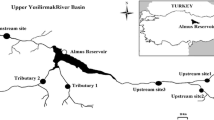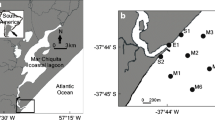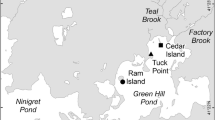Abstract
Apalachicola Bay lies at the mouth of the Apalachicola River, where seasonally variable freshwater inflows and shifting winds have long been thought to contribute to the support of an unusually productive and commercially important oyster fishery. Links between the river and productivity have been shown to lie in salinity-induced reductions in oyster predators and oyster disease as well as organic supplements from an extensive floodplain. Several studies have also indicated that nitrogen (N) and phosphorous (P) carried by the river are important in fertilization of bay primary production. While there is concern that upstream water withdrawals may impact the fishery, the importance of riverine N to oyster diets remains unclear. We measured N and carbon (C) stable isotopes (δ15N, δ13C) in macroalgae, surface-water nitrate, and surface sediments, which showed a gradient from enriched riverine δ15N values to more depleted values in the Gulf of Mexico. In contrast, δ13C of particulate matter is depleted in the river and enriched offshore. Oyster stable isotope values throughout Apalachicola Bay are more complex, but are dominated by freshwater inputs and reflect the variability and hydrodynamics of the riverine inflows.






Similar content being viewed by others
References
Caut, S., E. Angule, and F. Courchamp. 2009. Variation in discrimination factors (delta 15 N and 13 C): The effect of diet isotopic values and applications for diet reconstruction. Journal of Applied Ecology 46: 443–453.
Chanton, J.P., and F.G. Lewis. 1999. Plankton and dissolved inorganic carbon composition in a river-dominated estuary: Apalachicola Bay, Florida. Estuaries 22: 575–583.
Chanton, J., and F.G. Lewis. 2002. Examination of coupling between primary and secondary production in a river-dominated estuary: Apalachicola Bay, Florida, U.S.A. Limnology and Oceanography 47: 683–697.
Christensen, J.D., M.E. Monaco, T.A. Batista, C.J. Klein, R.J. Livingston, G. Woodsum, B. Galperin, and W. Huang. 1998. Potential impacts of freshwater inflow on Apalachicola Bay, FL oyster (Crassostrea virginica) populations: Coupling hydrologic and biological models. Silver Spring: NOAA/NOS Strategic Environmental Assessments Division. 58 pp.
Cohen, R.A., and P. Fong. 2006. Using opportunistic green macroalgae as indicators of nitrogen supply and sources to estuaries. Ecological Applications 16: 1405–1420.
Cole, M., I. Valiela, K. Kroeger, G. Tomasky, J. Cebrian, C. Wigand, R. McKinney, S. Grady, and M. Carvalho da Silva. 2004. Assessment of a 15 N isotopic method to indicate anthropogenic eutrophication in aquatic ecosystems. Journal of Environmental Quality 33: 124–132.
Costanzo, S.D., M.J. O'Donohue, W.C. Dennison, N.R. Loneragan, and M. Thomas. 2001. A new approach for detecting and mapping sewage impacts. Marine Pollution Bulletin 42: 149–156.
Dillon, K.S., and J.P. Chanton. 2008. Nitrogen stable isotopes of macrophytes assess stormwater nitrogen inputs to an urbanized estuary. Estuaries and Coasts 31: 360–370.
Edmiston, L. 2008. A River Meets the Bay—a characterization of the Apalachicola River and Bay System. Apalachicola: Apalachicola National Estuarine Research Reserve, Florida Department of Environmental Protection.
Elder, J., and H. Mattraw. 1982. Riverine transport of nutrients and detritus to the Apalachicola Bay Estuary, Florida. Water Resources Bulletin 18: 849–856.
Fertig, B., T. Carruthers, W. Dennison, A. Jones, F. Pantus, and B. Longstaff. 2009. Oyster and macroalgae bioindicators detect elevated delta 15 N in Maryland's coastal bays. Estuaries and Coasts 32: 773–786.
Fry, B. 2006. Stable isotope ecology. New York: Springer.
Grasshoff, K. 1976. Methods of sea water analysis, 2nd ed. Weinheim: Verlag Chemie.
Huang, W., H. Sun, S. Nnaji, and W.K. Jones. 2002a. Tidal hydrodynamics in a multiple-inlet estuary: Apalachicola Bay, Florida. Journal of Coastal Research 18: 647–684.
Huang, W., W.K. Jones, and T.S. Wu. 2002b. Modelling wind effects on subtidal salinity in Apalachicola Bay, Florida. Estuarine, Coastal and Shelf Science 55: 33–46.
Karsh, K.L., T.W. Trull, M.J. Lourey, and D.M. Sigman. 2003. Relationship of nitrogen isotope fractionation to phytoplankton size and iron availability during the Southern Ocean Iron Release Experiment (SOIREE). Limnology and Oceanography 48: 1058–1068.
Klinck, J. M., E. N. Powell, E. E. Hofmann, E. A. Wilson, and S. M. Ray (1992) Modeling oyster populations: the effect of density and food supply on production. In: M. Takahashi, K. Nakata, and T. Parsons (eds.) Proceedings of the Advanced Marine Technology Conference, Vol 5, Tokyo, pp. 85–105
Livingston, R. J. 1983. Resource Atlas of the Apalachicola Estuary. Florida Sea Grant Report No. 55.
Livingston, R. J. 1984. The ecology of the Apalachicola Bay system an estuarine profile. U.S. Fish and Wildlife Service, FWS/OBS 82/05, Washington, D.C.
Livingston, R.J., F.G. Lewis, G.C. Woodsum, X. Niu, B. Galperin, W. Huang, C. JD, M.E. Monaco, T.A. Battista, C.J. Klein, R.L. Howell, and G.L. Ray. 2000. Modeling oyster population response to variation in freshwater input. Estuarine, Coastal and Shelf Science 50: 655–672.
Livingston, R. J., Leitman, S., Woodsum, G. C., Galperin, B., Homann, P., Christensen, J. D., and M. E. Monaco. 2003. Relationships of river flow and productivity of the Apalachicola River-Bay system. Final Report DEP-ACF00109844 to NOS/CCMA/Biogeography Program under Florida State University and NOAA.
Mattraw, H.C., and J.F. Elder. 1982. Nutrient and detritus transport in the Apalachicola River, Florida. U.S. Geological Survey Water Supply Paper 2196-C. Washington: U.S. Govt. printing Office.
Mortazavi, B., R.L. Iverson, W.M. Landing, F.G. Lewis, and W. Huang. 2000a. Control of phytoplankton production and biomass in a river-dominated estuary: Apalachicola Bay, Florida USA. Marine Ecology Progress Series 198: 19–31.
Mortazavi, B., R.L. Iverson, W. Huang, F.G. Lewis, and J.M. Caffrey. 2000b. Nitrogen budget of Apalachicola Bay, a bar-built estuary in the northeastern Gulf of Mexico. Marine Ecology Progress Series 195: 1–14.
Mortazavi, B., R.L. Iverson, W.M. Landing, and W. Huang. 2000c. Phosphorus budget of Apalachicola Bay: a river-dominated estuary in the northeastern Gulf of Mexico. Marine Ecology Progress Series 198: 33–42.
Mortazavi, B., R. Iverson, and W. Huang. 2001. Dissolved organic nitrogen and nitrate in Apalachicola Bay, Florida: spatial distributions and monthly budgets. Marine Ecology Progress Series 214: 79–91.
Needoba, J.A., N.A. Waser, P.J. Harrison, and S.E. Calvert. 2003. Nitrogen isotope fractionation in 12 species of marine phytoplankton during growth on nitrate. Marine Ecology Progress Series 255: 81–91.
NERR. 2010. National Estuarine Research Reserve Centralized Data Management Office. http://cdmo.baruch.sc.edu/. Accessed 6 Jun 2010.
Oczkowski, A., S. Nixon, K. Henry, P. DiMilla, M. Pilson, S. Granger, B. Buckley, C. Thornber, R. McKinney, and J. Chaves. 2008. Distribution and trophic importance of anthropogenic nitrogen in Narragansett Bay: an assessment using stable isotopes. Estuaries and Coasts 31: 53–69.
Putland, J.N., and R.L. Iverson. 2007a. Phytoplankton biomass in a subtropical estuary: Distribution, size composition, and carbon:chlorophyll ratios. Estuaries and Coasts 30: 878–885.
Putland, J.N., and R.L. Iverson. 2007b. Microzooplankton: Major herbivores in an estuarine planktonic food web. Marine Ecology Progress Series 345: 63–73.
Riera, P., and P. Richard. 1997. Temporal variation of δ13C in particulate organic matter and oysters Crassostrea gigas in Marennes-Oléron Bay (France): Effect of freshwater inflow. Marine Ecology Progress Series 147: 105–115.
Seager, R., A. Tzanova, and J. Nakamura. 2009. Drought in the Southeastern United States: Causes, variability over the last millennium and the potential for future hydroclimate change. Journal of Climate 22: 5021–5045.
Sigman, D.M., K.L. Casciotti, M. Andreani, C. Barford, M. Galanter, and J.K. Böhlke. 2001. A bacterial method for the nitrogen isotopic analysis of nitrate in seawater and freshwater. Analytical Chemistry 73: 4145–4153.
Sun, H., and M. Koch. 2001. Case study: analysis and forcasting of salinity in Apalachicola Bay, Florida, using Box-Jenkins ARIMA models. Journal of Hydraulic Engineering 127: 718–727.
U.S. EPA. 1983. Methods for the chemical analysis of water and wastes, EPA – 600/4-70-020, revised March 1983, Method 365.3 and 365.5. USEPA, Ohio.
U.S. EPA. 1997. Determination of nitrate and nitrite in estuarine and coastal waters by gas segmented continuous flow colorimetric analysis. In Methods for chemical analysis of water and wastes, Revision 2, Method 353.4, ed. P.B. Ortner and C.J. Fisher. Ohio: US EPA.
USGS. 2010. USGS Surface-Water Data for the Nation. http://waterdata.usgs.gov/nwis/sw. Accessed 6 Jun 2010.
Wang, H., W. Huang, M. Harwell, L. Edmiston, E. Johnson, P. Hsieh, K. Milla, J. Christensen, J. Stewart, and X. Liu. 2008. Modeling oyster growth rate by coupling oyster population and hydrodynamic models for Apalachicola bay, Florida, USA. Ecological Modelling 211: 77–89.
Wilber, D.H. 1992. Associations between freshwater inflows and oyster productivity in Apalachicola Bay, Florida. Estuarine, Coastal and Shelf Science 35: 179–190.
Wilson, R.M., J. Chanton, G. Lewis, and D. Nowacek. 2009. Combining organic matter source and relative trophic position determinations to explore trophic structure. Estuaries and Coasts 32: 999–1010.
Wilson, R.M., J. Chanton, G. Lewis, and D. Nowacek. 2010. Concentration-dependent stable isotope analysis of consumers in the upper reaches of a freshwater-dominated estuary: Apalachicola Bay, Florida, U.S.A. Estuaries and Coasts 33: 1406–1419.
Acknowledgments
We thank Jenna Wanat from the Apalachicola Bay National Estuarine Research Reserve for her assistance in sample collection, Tiffany Heywood from the University of Rhode Island for laboratory assistance, Carol Thornber for macroalgae identification, and Rick McKinney from the U.S. EPA for use of the IRMS. This work was partially supported by the Florida Department of Environmental Protection and by NOAA's Dr. Nancy Foster Scholarship Program for A. Oczkowski. Although the research described in this article has been funded in part by the U.S. Environmental Protection Agency it has not been subjected to agency-level review. Therefore, it does not necessarily reflect the views of the agency. The statements, findings, conclusions, and recommendations are those of the authors and do not necessarily reflect the views of NOAA or the Department of Commerce. Mention of trade names or commercial products does not constitute endorsement or recommendation for use. This is contribution number AED-10-062 of the EPA Office of Research and Development, National Health and Environmental Effects Research Laboratory at the Atlantic Ecology Division.
Author information
Authors and Affiliations
Corresponding author
Rights and permissions
About this article
Cite this article
Oczkowski, A.J., Lewis, F.G., Nixon, S.W. et al. Fresh Water Inflow and Oyster Productivity in Apalachicola Bay, FL (USA). Estuaries and Coasts 34, 993–1005 (2011). https://doi.org/10.1007/s12237-011-9383-9
Received:
Revised:
Accepted:
Published:
Issue Date:
DOI: https://doi.org/10.1007/s12237-011-9383-9




